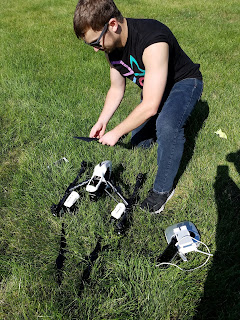When we all first arrived we were watching Evan and Pete performing the pre-flight checklist. The ground control station (GCS) was already set up. We all watched as Evan and Pete carefully performed the pre-flight checklist. The checklist was more involved than previous ones we had done. The person reading the checklist off was to listen for a certain verbal cue to move on. Depending on what was checked off, the person physically checking would say check, clear, rubbers on, etc... for different actions. Since pictures speak a thousand words, the post will now show what we as a class got to experience.
Upon arriving at Martell, the first thing we saw was C-Astrals Bramor. Roughly 4 feet in wingspan and less than half of that front to back, the flying wing had a good size to it. Asking Marko (C-Astral CEO) about the airframe design and material, he said it was made of Kevlar and reinforced fiberglass. Looking into the airframe you could also see carbon fiber.
To the left, Dr. Hupy (far right with the boonie hat) and Pete (far left with the boonie hat) troubleshooting an issue with the Bramor. Still performing the pre-flight checklist. Looking closely, just aft of the midsection of the flying wing you can see a red box like figure. This is the parachute, the Bramors only method of landing (safely).
After performing all pre-flight checklist items, the Bramor was now ready to fly. The bungee assisted catapult launch was ready and sprung back. With the release of a button the Bramor would be launched into the air to begin its mapping mission.
This video is the Bramor as it is being launched, as you can see the catapult is very powerful. In less than a second it is accelerated from the catapult into flight.
While we were there we were also able to watch a flight of the hexacopter there. While not C-Astral's airframe, it was still a very interesting airframe. One very cool sensor this airframe had was a thermal imagery sensor. There are no photos of this due to the environment causing to much reflection but seeing this sensor in action was very interesting. The hexacopter was flown to get thermal imagery of the field. Below are a few photos of it.
 |
| The hexacopter with the "cockpit" open |
 |
| Hexacopter without the arms, preflight |







